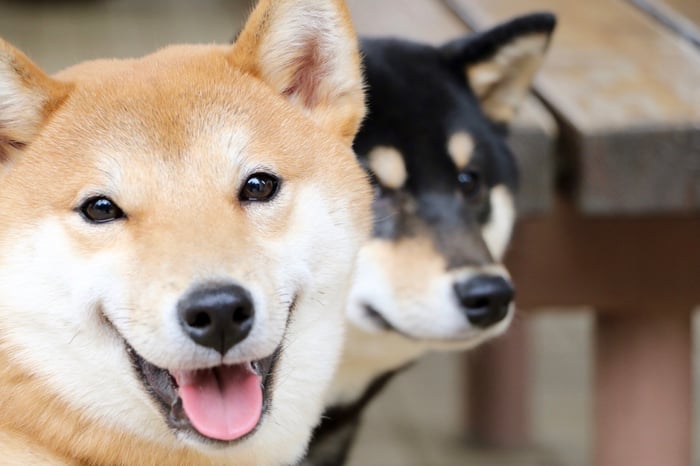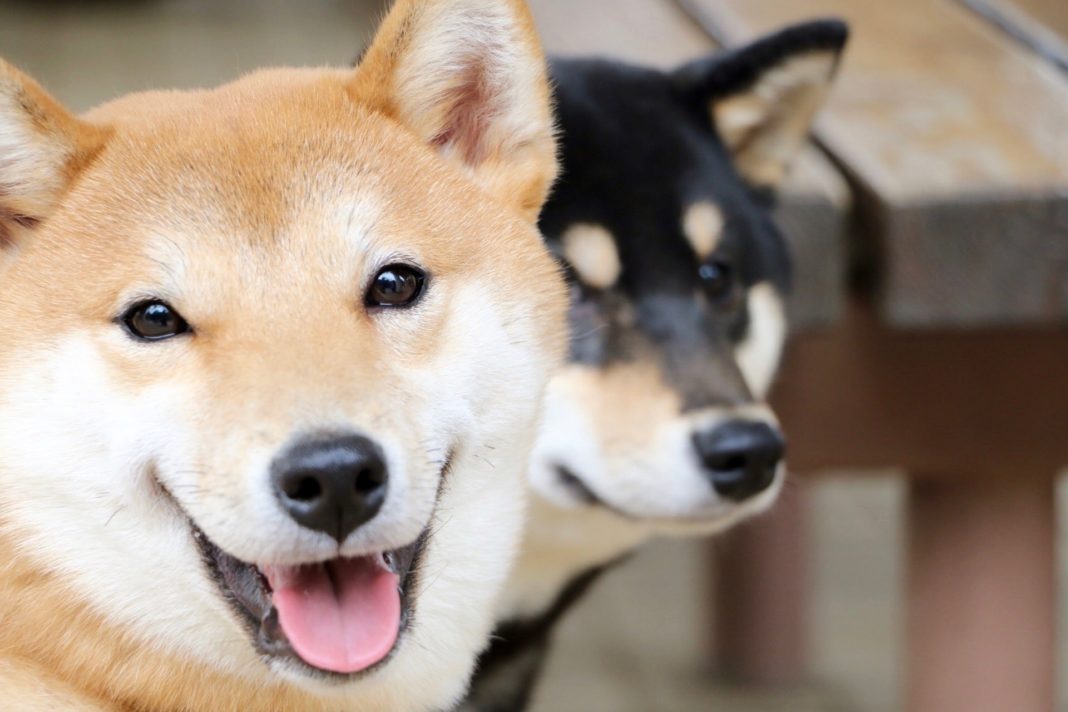No asset class has been hotter since the coronavirus pandemic bottom in March 2020 than cryptocurrencies. Over the past 21 months, the aggregate value of digital currencies has vaulted higher by more than 1,500% to $2.31 trillion, as of Dec. 12.
As you might imagine, Bitcoin and Ethereum (CRYPTO:ETH) have played a big role in these gains. After all, these two digital currencies comprise 62% of the aforementioned $2.31 trillion market cap.
But if we’re talking purely about performance, meme coin Shiba Inu (CRYPTO:SHIB) has delivered what might be the biggest single-year gain we’ll ever witness.

Crypto investors have piled into Shiba Inu-themed coins in 2021. Image source: Getty Images.
Shiba Inu went to the moon this year but will almost certainly struggle in 2022
According to CoinMarketCap.com, investors could have picked up SHIB at midnight on Jan. 1 for a mere $0.000000000073 per token. Over the course of 11 months and 12 days, these same tokens have eaten up six zeroes and now go for closer to $0.000037. In total, we’re talking about a year-to-date gain of 50,588,941%. This means an investment of just $2 at midnight on Jan. 1 would have made an investor a millionaire, as of Dec. 12.
The gains in Shiba Inu are the result of numerous factors, including the fear of missing out (FOMO), more crypto exchanges listing SHIB for trading, the launch of decentralized exchange ShibaSwap, coin burn, and the excitement surrounding future developments, such as layer-2 blockchain project Shibarium and the launch of nonfungible token (NFT)-based gaming.
Unfortunately, the social media hype surrounding Shiba Inu coin doesn’t match its real-world outlook. For a fringe top-10 token, in terms of market value, Shiba Inu has virtually no utility. Just 385 merchants worldwide are accepting SHIB as a form of payment, and more than 10% of these “merchants” are simply crypto exchanges.
Shiba Inu also offers no competitive advantages or differentiation. It’s an ERC-20 token built on the Ethereum blockchain, meaning it’s subject to the same high transaction fees and processing lag times that occasionally affect the Ethereum network. There’s simply nothing about this project that’s going to help it stand out from the more than 15,000 listed cryptocurrencies.
To boot, the track record for cryptocurrencies that deliver life-altering gains over a short time frame isn’t good. Virtually all of them eventually go on to lose 90% or more of their value.
This crypto trio can crush SHIB next year
As we ready to turn the page to a new year, the following trio of cryptocurrencies all have the tools and story necessary to allow them to run circles around Shiba Inu in 2022.

Image source: Getty Images.
Axie Infinity
If crypto investors are enamored with the prospects of blockchain-based gaming, they should consider Axie Infinity (CRYPTO:AXS), which looks to have a good shot at handily outperforming SHIB next year.
Axie Infinity is a play-to-earn game designed on the trusted Ethereum blockchain. Users collect, raise, breed, and battle figures known as Axies (a minimum of three Axies is needed to go to battle). The winning user of a battle receives experience points, which can then be used to upgrade their Axies.
What’s important to note is that each Axie is an NFT. This means it can be monetized by users within the game or potentially sold or purchased in a marketplace. NFTs were all the rage in 2021, and the ability to earn money while playing games will likely continue to draw users to Axie Infinity’s platform in the upcoming year.
Another reason to trust in Axie Infinity is the real-world dollar figures behind this project. Over the past six months, roughly $1.2 billion in combined revenue was collected, according to Token Terminal. That places Axie behind only Ethereum ($4.5 billion) in terms of blockchain-based decentralized application (dApp) revenue over this six-month span.
With popularity and real-world use, Axie Infinity is in prime position to leave Shiba Inu in the dust.

Image source: Getty Images.
Avalanche
Another cryptocurrency with a real shot to crush Shiba Inu’s returns in 2022 is Avalanche (CRYPTO:AVAX).
The superficial lure of Avalanche is the speed of its blockchain. Its development team has pegged the networks’ processing capacity at 4,500 transactions per second (TPS). To put this into some perspective, Bitcoin (before the Taproot upgrade) and Ethereum have been processing at a respective 7 TPS and 13 TPS.
In addition to superior scalability, Avalanche’s transactional finality is far more impressive than the “Big Two.” On average, transfers of money, files, or data on Avalanche’s blockchain are completed in under two seconds. This compares to an average transaction completion wait time of six minutes for Ethereum and closer to an hour for Bitcoin.
But what might be the most appealing aspect of Avalanche is its compatibility with the ultra-popular Ethereum network. With the Ethereum Virtual Machine already running on the Avalanche network, it shouldn’t be difficult to poach dApp developers from Ethereum — especially considering the speed, cost, and execution advantages described above.
Over the past 30 days, Avalanche ranks sixth in protocol dApp revenue generated on its blockchain, per Token Terminal ($16.4 million). With real-world appeal, it shouldn’t have any trouble putting SHIB in the rearview mirror.

Image source: Getty Images.
Cardano
A third digital currency that can run circles around Shiba Inu next year is the ultra-popular Cardano (CRYPTO:ADA).
As I’ve previously pointed out, the transparency and regular upgrades associated with the Cardano blockchain is what makes it so exciting. In July 2020, the Cardano development team executed what became known as the Shelley upgrade. This allowed network participants to run a larger number nodes. Subsequent to this upgrade, the average number of daily transactions on Cardano’s blockchain skyrocketed from around 2,000 to north of 100,000.
What’ll really make Cardano a blockchain network of choice for dApp developers is the Goguen update, which was executed in September. Goguen introduced smart contracts to the Cardano blockchain. Smart contracts help to verify, enforce, and facilitate the negotiation of a contract between two parties. Over time, smart contract capability should allow Cardano to go toe-to-toe with Ethereum.
There’s also the Hydra upgrade, which has no specified release date. Hydra is a layer-2 blockchain that’s designed to move transactions to staking pools off the main blockchain. This should vastly improve the speed of the network while lowering costs.
Suffice it to say, Cardano has a much brighter future than Shiba Inu.
This article represents the opinion of the writer, who may disagree with the “official” recommendation position of a Motley Fool premium advisory service. We’re motley! Questioning an investing thesis — even one of our own — helps us all think critically about investing and make decisions that help us become smarter, happier, and richer.






